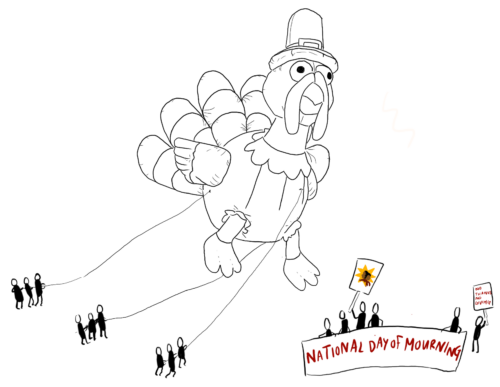Every Thanksgiving, millions of Americans gather around dinner tables to celebrate a holiday steeped in tradition and controversy. On the day of Thanksgiving at 8:00 a.m., an army of floats, balloons, and elaborate costumes marched down New York City’s Central Park West. This year was the 100th anniversary of the Macy’s Thanksgiving Day Parade, an annual event with significant ties to the American cultural tradition—around 3.5 million people view the parade live every year, and 30 million Americans watch it on television from home.
For many, Thanksgiving is a day of thanks, celebration, and quality time with family and friends. However, not everyone celebrates this holiday or embraces its meaning. For some, the holiday is a reminder of the centuries of American oppression and bloodshed against Native Americans.
This past November, the Boston City Council adopted a resolution recognizing Nov. 28, 2024, as “National Day of Mourning” in Boston. Since 1970, Native American tribes across the United States have celebrated the National Day of Mourning (NDOM) in lieu of Thanksgiving. For the Wampanoag, the day is remembering Native Americans who have died due to European colonization and remembering the injustices—genocide, land theft, and poverty—that Native Americans faced due to European settlers.
“Thanksgiving Day is a reminder of the genocide of millions of Native people, the theft of Native lands and the erasure of Native cultures. Participants in National Day of Mourning honor Indigenous ancestors and Native resilience,” the United American Indians for New England’s website reads. “It is a day of remembrance and spiritual connection, as well as a protest against the racism and oppression that Indigenous people continue to experience worldwide.”
The NDOM protest takes place every year, where people gather at Cole’s Hill in Plymouth, Massachusetts, for marches and rallies.
However, the way that Harvard engages with the complicated legacy attached to Thanksgiving is an ongoing discussion. Harvard has a long and complex history with Native American tribes. Harvard’s campus is built on the ancestral land of the Massachusett tribe, the original inhabitants of what is now known as Boston and Cambridge. Native Americans have always been a part of Harvard’s history. In the Harvard Charter of 1650, Henry Dunster specifically outlined that the College “may conduce to the education of the English and Indian youth of the country.”
In more recent years, Harvard has made efforts to rectify injustices experienced by Native Americans. In 2009, the College commissioned a painting of Caleb Cheeshahteaumuck, the first Native American to graduate from the College. Alumnus Stephen Coit ’71 finished the portrait, and it was placed in the Annenberg dining hall among other famous figures in Harvard’s history. In addition, the University published and has continued to re-state a land acknowledgment. In 2019, the Harvard University Native American Program (HUNAP) Faculty Advisory Board members started a series of conversations with the Massachusett Tribe to discuss the ways that HUNAP could honor the land that Harvard occupies and its continued ties to the Massachusett people.
In 2017, Harvard officially recognized both Columbus Day and Indigenous Peoples’ Day on the University’s calendar. In an interview with The Harvard Crimson, Ashley N. Hamilton ’20, a member of the Winnebago Tribe of Nebraska, explained the significance of the renamed holiday for Native American students. “It’s a celebration of our survival in that we’re still here, thriving, even though it’s not really known,” said Hamilton.
Several years after the official recognition in the school’s calendar, in October 2023, Native American students at Harvard College and HUNAP co-hosted an Indigenous Peoples Day celebration in Harvard Yard. In the three-hour event, students served Native foods, recited poems, danced traditional Hula dances, and rapped. There was a keynote speaker in addition to an open mic where students shared their art, ranging from songs to poems, relating to their Native ancestry. The co-president of Native Americans at Harvard College (NAHC), Lena M. Tinker ’25, described the meaning behind the event. “Having a space where we’re not just doing education and talking about Columbus and that particular history—where we actually get to bring our Indigenous presence and celebrate our community and celebrate all of our stories in our very diverse community and ways of walking in this world as an Indigenous person—is really special,” she explained.
Harvard’s efforts to engage with its history and support Native American communities reflect a growing acknowledgment of the complexities surrounding Thanksgiving. As celebrations and protests continue to intertwine, the holiday serves as a moment for both gratitude and accountability—a chance to honor traditions while confronting the complex narratives and legacies that shape them.
Pippa Lee ’28 (pippalee@college.harvard.edu) writes News for the Independent.

